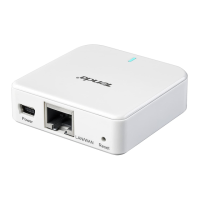by the server or Internet applications.
LAN IP: Enter an IP address of the computer to work as a
server in LAN.
Protocol: Includes TCP, UDP and Both. Select “Both” when
you are not sure about which protocol to use.
Enable: Check the “Enable” option to activate a
corresponding entry next to it.
Delete: Check the “Delete” option to delete a
corresponding entry next to it.
Well-Known Service Port: The “Well-Known Service Port”
provides commonly used protocol ports. Select one from
them and then click the “Add to” button to automatically
add selected port to the Start Port-End Port fields of
selected entry ID. You can also manually add the ports
which are not included in the “Well-Known Service Port”.
Add to: Add a selected Well-Known Service Port to the Start
Port-End Port boxes of the entry you select.
For example: A LAN PC at 192.68.2.10 hosts WEB service on Port
80 and provides Telnet service on Port 23. To make such services
accessible to Internet users, config as shown on the screenshot
above.
Note: If you include port 80 on this section, you must set the port
on remote (web-based) management section to a different
number than 80, such as 8080, otherwise the Port Range
Forwarding feature may not take effect.

